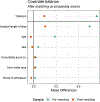Survivor Average Causal Effects for Continuous Time: A Principal Stratification Approach to Causal Inference With Semicompeting Risks
- PMID: 40047176
- PMCID: PMC11887578
- DOI: 10.1002/bimj.70041
Survivor Average Causal Effects for Continuous Time: A Principal Stratification Approach to Causal Inference With Semicompeting Risks
Abstract
In semicompeting risks problems, nonterminal time-to-event outcomes, such as time to hospital readmission, are subject to truncation by death. These settings are often modeled with illness-death models for the hazards of the terminal and nonterminal events, but evaluating causal treatment effects with hazard models is problematic due to conditioning on survival-a posttreatment outcome-that is embedded in the definition of a hazard. Extending an existing survivor average causal effect (SACE) estimand, we frame the evaluation of treatment effects in the context of semicompeting risks with principal stratification and introduce two new causal estimands: the time-varying survivor average causal effect (TV-SACE) and the restricted mean survivor average causal effect (RM-SACE). These principal causal effects are defined among units that would survive regardless of assigned treatment. We adopt a Bayesian estimation procedure that parameterizes illness-death models for both treatment arms. We outline a frailty specification that can accommodate within-person correlation between nonterminal and terminal event times, and we discuss potential avenues for adding model flexibility. The method is demonstrated in the context of hospital readmission among late-stage pancreatic cancer patients.
Keywords: causal inference; hospital readmission; principal stratification; semicompeting risks; survivor average causal effect.
© 2025 Wiley‐VCH GmbH.
Conflict of interest statement
Conflict of Interest
The authors have declared no conflict of interest. (or please state any conflicts of interest)
Figures




References
-
- Bartolucci F and Grilli L (2011). Modeling partial compliance through copulas in a principal stratification framework. JASA 106, 469–479.
-
- Chen D, Li J, and Chong JK (2017). Hazards regression for freemium products and services: a competing risks approach. Journal of Statistical Computation and Simulation 87, 1863–1876.
-
- Fine JP, Jiang H, and Chappell R (2001). On semi-competing risks data. Biometrika 88, 907–919.
MeSH terms
Grants and funding
LinkOut - more resources
Full Text Sources

